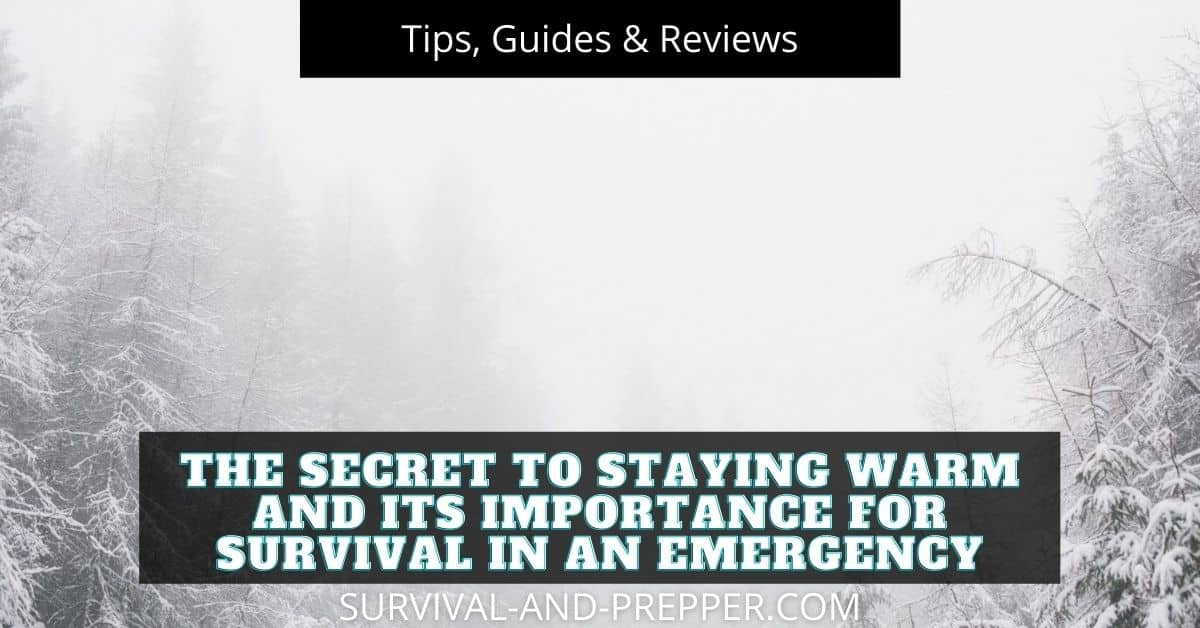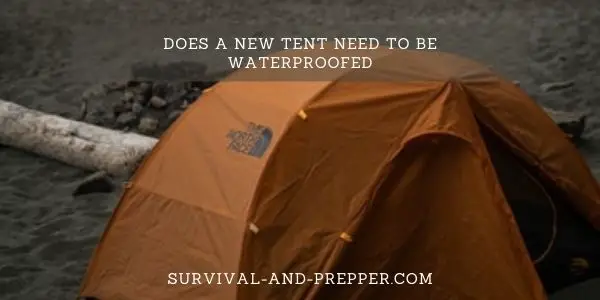The Secret to Staying Warm and Its Importance for Emergency Survival
The Dangers of Hypothermia and Extreme Cold
Extreme cold can pose significant dangers to the human body. With temperatures in large portions of the US capable of dropping below freezing it is important to know how to deal with this cold if you are faced with less than ideal temperatures. It is estimated that hypothermia can begin setting in in less then ten minutes when dealing with subzero temperatures. This does not leave a lot of time for figuring out a plan when it becomes necessary to do so. Because of this you need to have a plan for staying warm already formulated ahead of time.
The key to staying warm in any condition is shelter from the elements. Shelter can be in the form of a physical structure, clothing to protect you or even a heat source to drive back the cold. In a perfect world you would be in a warm and cozy home. However, this is often not the case. Let’s look into some ways that you take to help you with staying warm.
Staying Warm without a Heater in Your Home
There will be times when you may find yourself home without heat. More often this is more of a problem for those who use electricity or gas to heat their homes than it is for those who use wood. This is due largely to the effects of external factors on the gas lines and electric grid. Where as firewood is frequently stored in abundance ahead of time.
Blizzards, snowstorms and even trees falling due to Icey conditions can all cause failures of power and gas systems. Therefore it is important to know how to stay warm if you loose the heating supply in your residence.
How Long Will a House Stay Warm without Power?
The first thing you need to know is how long will a house stay warm without power or gas? Several factors play into answering this question. Some of these include temperature outside, insulating factors and beginning temperature inside.
In nearly every instance the temperature inside of the house will stay warm for at least twelve hours. Even though it will continue to lower as time goes by.
Despite this decrease the temperature inside of the house will generally remain warmer than outside during the night. It may be either warmer or colder than the outside in the daytime due to the sun’s warming effect. The shelter provided by the walls will greatly reduce the wind chill creating a warmer environment. This benefit should not be discounted even if it is slightly warmer outside.
Tips on How to Stay Warm without a Heater?
So if your heater is out in your home how can you stay warm until it is restored.
- Wear Additional Layers of Clothing – Dress in layers instead of one large bulky garment. This will allow you to better regulate your temperature if needed.
- Use Additional Blankets – For obvious reasons adding additional layers to your bed will help you to stay warmer. This will also allow you to conserve energy if you use it to maintain your body heat.
- Minimize the Space You Are Using – Use either heavy blankets, plastic or some other material to block off portions of the home you are not using. Frequently gathering everyone in either a single bedroom or the kitchen area tends to be the better idea. This will allow activities and people in that room to increase the temperature slightly. If you are able to produce limited heat, prolong that by confining it to a smaller area.
- Consider Alternative Heat Sources – Do you have a fireplace you don’t normally use? Access to wood? Then maybe now is the time to resort to that. Gas stove but no electricity, use the gas oven to add heat. electricity but no gas, use extra lights, electric heaters or even an electric stove to increase the heat. Even lighting multiple candles will produce limited amounts of heat. Just be careful of carbon monoxide levels if using a burning material. Do not build open fires in an area that is not properly vented.
- Instead of a Fire Inside, Consider One Outside – If you do not have a fireplace you can still benefit by building a fire outside. In this case you would want to heat extra blankets or even water with that fire to transfer some heat back inside of your residence. In some cases an outside fire may be a better idea, especially if you need to burn some unconventional materials in an emergency situation.
Check out our article on Fatwood, an excellent all natural fire-starter.
Staying Warm without the Safety of a Building
Staying warm without the safety of a building can become much more challenging. We are talking about if you find yourself stranded outside without any shelter and needing to make do. This section does not cover staying warm in a tent or in a prepared scenario such as a planned camping trip.
If you plan to hike in the snow it is important that you have a plan on how to stay warm in a survival situation.
It is extremely important that you keep in mind the need for shelter in extreme cold. Your first goal over anything else should be seeking some form of shelter. This could be in the form of a structure such as a home, barn or other building.
If none of those are readily available then consider vehicles, tents and natural objects that could protect you from the wind and snow such as large trees or boulders.
Caves are ideal as you can often remain dry in these and it is possible to start a small fire at the entrance to provide some heat without to many concerns of burning your structure down.
How to Stay Warm Without Heat in the Wilderness
When there are no other options though it is possible to build a shelter in snow.
These include a snow cave where you tunnel into an embankment to provide shelter from falling snow and wind. This is probably the easiest of the structures and requires nothing more than scraping out a small hollow area into the side of the bank large enough for you to fit into.
A tree pit where you take advantage of the holes that naturally form around the base of a tree in heavy snow. Often there are depressions around a tree formed by the limbs preventing snow fall. Use these to your advantage by carefully crawling into one and enlarging the space by removing snow. Once it is large enough for you to lay down pack the walls as tight as you can and cut small limbs to cover the top and help insulate the area.
Or last a version of shelter similar to an Igloo or a Quinzee. This the hardest of the three and you should consider the value of this structure over one of the previous two which are far easier and quicker to build. I would save this as a last resort in open terrain where you feel the likelihood of a quick rescue is unlikely.
In each of these shelters you can actually build a small fire inside. Keep the smoke in mind and make sure to create a small hole at the apex to allow this to escape. Also keep the fire small to avoid melting snow.
7 Tricks to Stay Warm in the Snow
- Keep Moving – Constant movement causes your body to produce more heat. This can help to keep you warm. At all costs you want to avoid becoming to sedentary for extended periods of time. At least until you have some form of shelter in place.
- Friction Produces Heat – If you find yourself out in the snow or extreme cold friction in addition to movement can warm you up. Friction is the rubbing of two things together and the heat that is produced from that action. You can see this effect when you put your hands together and rub them back in forth briskly. You will feel heat begin to build. As you walk continue to rub your arms and face to maintain that friction heat.
- Consume warm beverages- If you have the ability to heat water, consume warmer drinks this will help keep your body heat up.
- Minimize exposed skin- Obviously if you have prepared for this you have this covered. If not then it may be worthwhile to swap some layered clothing around to make sure any exposed skin is covered. This will help to minimize frost bite and keep heat in.
- Protect Your Extremities – Your fingers, toes, noes and ears are the most likely parts of the body to become frost bitten. Do your best to protect these areas if possible. One way to protect your hands is to tuck them into your arm pits when you aren’t using your hands. This will allow the heat from your core body to warm them.
- If you are forced to remain in an area for an extended time, try to dig your shelter deep enough into the ground to get past the frost line. The deeper you go the warmer the soil gets. Generally 1.5 to 2 feet is enough to notice the difference. However, this depends on where in the world you are.
- Remember that fire is nearly as important to your survival as shelter is. Make sure you learn now several ways to start a fire if a lighter is unavailable. Then remember to keep a fire kit with you whenever possible if venturing into the outdoors. One should be included as part of your vehicle’s survival kit as well.
What Tips Do You Use to Stay Warm When outside in the Winter?
Now that we have covered quite a few tips for staying warm in the snow and what to do in an emergency situation did you find anything useful? What other tips do you have that you use to stay warm in the winter? Answer below and then check out our other winter articles such as Hiking in the Snow and Tips to Stay Warm in a Tent.






